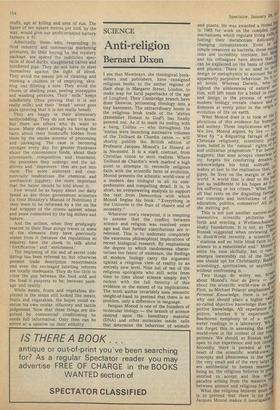SUPERMARKETING
Secret foods
Oliver Stewart
A shopper can now buy a month's supplies from the supermarket without setting eyes on anything looking remotely like an animal or a plant. Connections between the contents of the neat packages on the shelves and the rude fruits of the earth are as carefully hidden from him as was the source of babies from Victorian children.
It is a kind of censorship imposed upon the public by the food industry and it has extremely undesirable implications. For although its coy keeping date code has at last been broken by a leading store, the industry still does not think that it would be good for us to know too much about where the articles it sells in tins, bags, bottles, jars and wrappings come from or what it has done to them.
It would certainly not be pleasing for us to be reminded about the treatment of the living creatures which are processed to make up the fillings of some of the packs. Our sensibilities would be offended and we might refuse to buy.
There is, therefore, commercial justification for teaching simple, trusting modern man to think that the latest food production methods are all kindliness and light; that his factory-produced, ovenready chicken was found under a gooseberry bush and that his packaged lamb chop was brought by the stork.
It is likewise commercially desirable that he should be conned into believing that a ' garden pea' is a bright green pellet obtainable all the year round from a tin or packet; that potatoes are crinkly yellow papyrus flakes; and that pears are specimens of cellular material bottled, like an exhibit in a hospital museum, in preserving liquid.
Today a cook can work without perceiving any relationship between his stores of preserved and packaged provisions and life, growth, seasonal cycles, climatic effects, soil influences or growing crops and grazing herds. Does it matter?
Listen to the bland reassurances of the scientists of the Ministry of Agriculture, Fisheries and Food. They are dogmatic and absolute. The popular supposition, they haughtily declare, that natural foods, freshly gathered, and free range animals, undoped and unconfined, make the best kinds of food is a load of rubbish.
Such natural foods, they go on, have no significant' nutritional advantage and, when they come to the kitchen, are no different from the embalmed cadavers bought from the supermarkets.
But gourmets and cookery experts do not agree. They want to know all about the kind of life led by the organism — animal or vegetable — they are going to eat. In France pernickety chefs demand very detailed information, such as is given, for instance, in the sealed guarantee that goes with a poulet de Bresse. This particularises manner of rearing, feeding stuffs, age at killing and area of run. The figure of ten square metres per bird, by the way, would give our profit-oriented battery farmers a fit.
Admittedly those who, responding to food industry and commercial marketing pressures, do their buying by the mystery package, are spared the indelicate spectacle of dead ducks, slaughtered calves and butchered pigs. They do not have to steel themselves against the sight of blood. They avoid the messy job of cleaning and trussing a chicken or of emptying, skinning and filleting a sole. They avoid the chores of shelling peas, peeling pineapples and washing potatoes. Their milk' keeps indefinitely (thus proving that it is not really milk) and their ' bread ' never goes stale (proving that it is not really bread).
They are happy in their alimentary mollycoddling. They do not want to know. But there are others who do want to know. Many object strongly to having the facts about their foodstuffs hidden from them by the smoke screens of processing and packaging. The case is becoming stronger every day for greater frankness about the convenience foods; about their provenance, composition and treatment; the processes they undergo and the additives and ' improvers ' that are put into them. The more elaborate and commercially tendentious the chemical and mechanical jugglery, the more important that the buyer should be told about it.
Few would be as happy about our daily bread as are those government scientists (in their Ministry's Manual of Nutrition) if they were to be informed by a list on the loaf wrapper of the crimes against wheat and yeast committed by the big millers and bakers.
And the millers, when they grudgingly restore to their flour stingy traces of some of the elements they have previously stolen from it (because the regulations so require) have the cheek to talk about 'fortification' and 'enrichment.'
The beginning of the end of secret code dating has been referred to; but otherwise present trade description requirtments and even the envisaged labelling reforms are totally inadequate. They do too little to close the gap between the food sold and the food it purports to be; between package and reality.
While meats, fruits and vegetables displayed in the shops still looked like meats, fruits and vegetables, the buyer could exercise his own ocular, olfactory and tactile judgement. Now that these things are disguised by commercial conditioning he needs full information. Only then can he arrive at a opinion on their edibility.











































 Previous page
Previous page